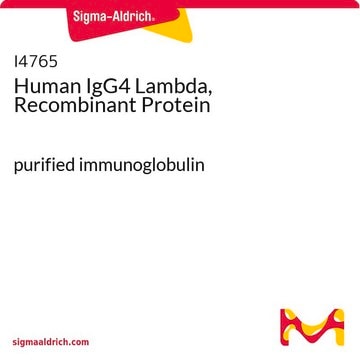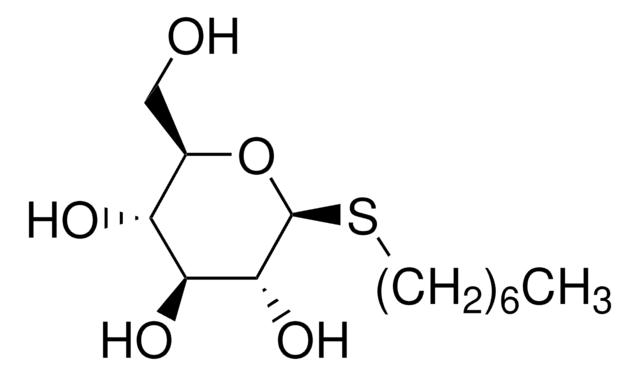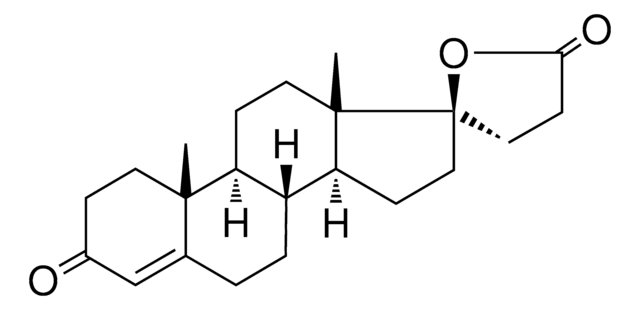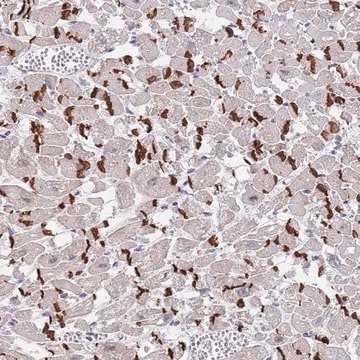14764
1-Deoxy-D-xylulose
≥80% (TLC)
Synonym(s):
(3S,4R)-3,4,5-Trihydroxy-2-pentanone, 1-Deoxy-D-threo-2-pentulose
Sign Into View Organizational & Contract Pricing
All Photos(1)
About This Item
Empirical Formula (Hill Notation):
C5H10O4
CAS Number:
Molecular Weight:
134.13
MDL number:
UNSPSC Code:
12352201
PubChem Substance ID:
NACRES:
NA.25
Recommended Products
Assay
≥80% (TLC)
form
liquid
optical activity
[α]/D +31.0±3.0°, c = 1 in H2O
storage temp.
−20°C
SMILES string
CC(=O)[C@@H](O)[C@H](O)CO
InChI
1S/C5H10O4/c1-3(7)5(9)4(8)2-6/h4-6,8-9H,2H2,1H3/t4-,5-/m1/s1
InChI key
IGUZJYCAXLYZEE-RFZPGFLSSA-N
Biochem/physiol Actions
Metabolite of the non-mevalonate pathway, generally found in prokaryotes, as precursor to isoprenoids as well as non-isoprenoids like vitamins. As this pathway is not present in humans, it is of interest for the development of bacterium-specific drugs in the search for treatments of infectious diseases.
Linkage
In E. coli, 1-deoxy-D-xylulose is converted into 1-deoxy-D-xylulose 5-phosphate by phosphorylation of the C-5 hydroxy group by D-xylulokinase.
Other Notes
To gain a comprehensive understanding of our extensive range of Monosaccharides for your research, we encourage you to visit our Carbohydrates Category page.
Storage Class Code
13 - Non Combustible Solids
WGK
WGK 3
Flash Point(F)
Not applicable
Flash Point(C)
Not applicable
Choose from one of the most recent versions:
Certificates of Analysis (COA)
Lot/Batch Number
Don't see the Right Version?
If you require a particular version, you can look up a specific certificate by the Lot or Batch number.
Already Own This Product?
Find documentation for the products that you have recently purchased in the Document Library.
Andréa Hemmerlin et al.
Plant physiology, 142(2), 441-457 (2006-08-22)
Plants are able to integrate exogenous 1-deoxy-D-xylulose (DX) into the 2C-methyl-D-erythritol 4-phosphate pathway, implicated in the biosynthesis of plastidial isoprenoids. Thus, the carbohydrate needs to be phosphorylated into 1-deoxy-D-xylulose 5-phosphate and translocated into plastids, or vice versa. An enzyme capable
W Eisenreich et al.
Cellular and molecular life sciences : CMLS, 61(12), 1401-1426 (2004-06-16)
The mevalonate pathway for the biosynthesis of the universal terpenoid precursors, isopentenyl diphosphate (IPP) and dimethylallyl diphosphate (DMAPP), is known in considerable detail. Only recently, the existence of a second mevalonate-independent pathway for the biosynthesis of IPP and DMAPP was
Wanchai De-Eknamkul et al.
Phytochemistry, 62(3), 389-398 (2003-03-07)
A green callus culture of Croton sublyratus Kurz established from the leaf explants appeared to actively synthesize two well-known phytosterols, beta-sitosterol and stigmasterol. The phytosterol biosynthesis was highly active during the linear phase of the culture. Feeding of [1-13C]glucose into
Andréa Hemmerlin et al.
The Journal of biological chemistry, 278(29), 26666-26676 (2003-05-09)
In plants, two pathways are utilized for the synthesis of isopentenyl diphosphate, the universal precursor for isoprenoid biosynthesis. The key enzyme of the cytoplasmic mevalonic acid (MVA) pathway is 3-hydroxy-3-methylglutaryl-coenzyme A reductase (HMGR). Treatment of Tobacco Bright Yellow-2 (TBY-2) cells
J Schwender et al.
Planta, 212(3), 416-423 (2001-04-06)
The biosynthesis of the C5 building block of isoprenoids, isopentenyl diphosphate (IPP), proceeds in higher plants via two basically different pathways; in the cytosolic compartment sterols are formed via mevalonate (MVA), whereas in the plastids the isoprenoids are formed via
Our team of scientists has experience in all areas of research including Life Science, Material Science, Chemical Synthesis, Chromatography, Analytical and many others.
Contact Technical Service








